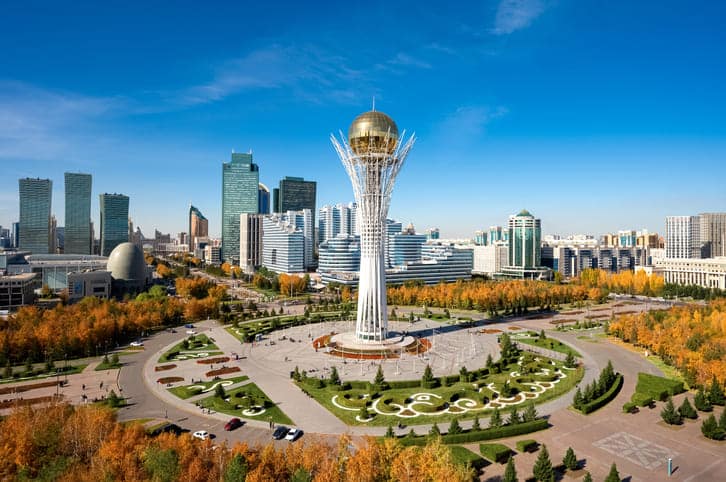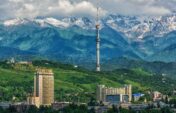Investing in Kazakhstan’s Agriculture: Seizing New Opportunities

For investors and global agri-food players, the country presents both a stabilising regional force and an emerging hub of opportunity.
In an era marked by mounting geopolitical uncertainties, climate disruptions, and supply chain fragility, food security has become a defining priority for nations across the globe. For Kazakhstan, Central Asia’s largest country by landmass and a rising agricultural power, this challenge is being met head-on through a wide-ranging effort to modernise its agri-food sector. The goals are to ensure domestic food availability and affordability, boost export potential, and build long-term resilience through diversification and sustainability.
Over the past few years, Kazakhstan has embarked on a comprehensive transformation of its agricultural landscape, with notable gains in local production, mechanisation, and value-added exports. The results are already evident: domestic food self-sufficiency for most critical products, fast-growing agri-export figures, and a clear policy alignment with climate resilience and the green economy.
New Trade Player
Kazakhstan is now expanding its agri-export footprint abroad. Over the past five years (from 2020 to 2024), agri-food exports surged by 51%, from $3.4 bn to $5.1 bn, reaching 66 markets worldwide. More significantly, value-added products now make up over 52% of all agri exports – a sign of structural improvement in the sector.
Much of this growth stems from the crop sector. Kazakhstan has signed new phytosanitary agreements with countries such as China, Turkey, Iran, and Azerbaijan, enabling the export of oilseeds, legumes, and cereals. For instance, Kazakh producers can now ship sunflower meal, lentils, and rapeseed to China. Ongoing negotiations include expanding market access rice, cotton, melons and watermelons.
Kazakhstan is actively adopting agricultural technologies to boost crop yields. For example, the use of fertilizers has increased 1.9 times over the past two years. The volume of elite seed usage has also grown, and the rate of agricultural machinery renewal is accelerating. Preferential loan products are available to support crop production and the upgrading of machinery. In 2024, favorable climatic conditions, combined with the adoption of modern agrotechnologies, have enabled Kazakhstan to harvest over 25 million tons of grain, 3.3 million tons of oilseeds, and 640 thousand tons of legumes.
The Sunflower Success Story
A standout example of Kazakhstan’s agricultural transformation is the oilseed processing industry – especially sunflower oil and meal. Backed by National Oilseed Processors Association of Kazakhstan, the country has emerged as a global contender in this high-value segment.
Over the last three marketing years, sunflower oil production in Kazakhstan has increased 2.5-fold, while exports have grown nearly fivefold. In 2023-2024, the country ranked eighth among global exporters of sunflower oil and entered the top three suppliers of sunflower meal to the EU.
According to industry forecasts, Kazakhstan could become one of the world’s top three exporters of sunflower oil in the medium term, raising annual foreign exchange earnings from the sector to $2 bn. The domestic market is now fully supplied, and Kazakhstan has positioned itself as a key supplier to neighbouring Central Asian countries.
China remains a particularly attractive market, importing over 18 million tonnes of vegetable oils and meals annually. Kazakh exports to China reached 275,000 tonnes in 2024 (worth $205 million), a 3.5-fold increase over two years. Following the 2023 signing of a new sanitary protocol with China’s customs authority, more than 30 Kazakh oilseed plants were granted export access that paves the way for further expansion.
Kazakhstan Bets on Deep Grain Processing
As global agricultural markets grow increasingly competitive, Kazakhstan is shifting focus – not only exporting raw commodities, but also investing heavily in the deep processing of agricultural products.
Today, deep grain processing is concentrated in several key regions. In Northern Kazakhstan, wheat is being transformed into gluten and biofuel. In the Almaty and Zhetysu regions, corn is processed into starch and its derivatives. A new wave of projects is also set to launch in the Kostanay and Turkistan regions, as well as in the capital, Astana. The range of planned outputs is broad, from lysine and gluten to bioethanol, glucose-fructose syrup, and starch-based products.
To accelerate growth in this strategic sector, the government has ramped up support: the investment subsidy rate has been raised from 25% to 50%. These targeted measures are designed to fast-track the development of high-value, export-oriented processing industries across the country.
From Red Gold to Green Growth: Kazakhstan Expands Meat and Organic Exports
Meanwhile, the animal product segment is gaining momentum as well, with over 3,500 Kazakh enterprises now included in foreign export registries. The diversification of export flows is in process while meeting rigorous quality and safety standards in international markets.
One of Kazakhstan’s most promising export categories is red meat, often referred to as “red gold.” Beef and lamb are in high demand in markets such as China, the Middle East and other countries. There is also strong export potential for by-products of poultry and livestock production, especially in the Chinese market, where work is underway to open new export channels.
Kazakh meat products are distinguished by their high quality, natural taste, and strong competitiveness — particularly in the premium chilled meat segment. Given the country’s 180 million hectares of pastureland and its favorable system of transhumance (seasonal livestock grazing), meat production has the potential to scale up significantly.
Currently, Kazakhstan exports meat to 8 countries. In the first five months of 2025 alone, around 40,000 tons of meat were shipped abroad, and efforts to expand access to new markets are ongoing.
Maintaining strict veterinary control is essential to supporting this growth. Significant progress has been made in this area, particularly in improving product traceability and strengthening the infrastructure of the veterinary system. Kazakhstan is actively investing in laboratory equipment, constructing veterinary stations across the country, and enhancing digital systems for tracking livestock products.
Organic Products as a New Niche
Another promising niche for Kazakhstan is the production of organic products. There is strong demand for organic wheat, flax, soybeans, peas, lentils, and medicinal herbs. Kazakhstan has established export channels to Germany, Sweden, Belgium, the Czech Republic, and several other countries.
For example, in 2023 alone, Kazakhstan exported 25,918 tonnes of products to the European Union and the United States, including oilseeds, pulses, and grain crops. Nationwide, there are 67 producers of organic products, 60 of which are certified under international standards, while seven hold national certification.
The country also has considerable potential for further growth. According to reports by the Research Institute of Organic Agriculture (FiBL) and the International Federation of Organic Agriculture Movements (IFOAM), the area of land in Kazakhstan certified under organic production standards reached nearly 200,000 hectares in 2023, up from 114,000 hectares in 2022. This demonstrates a growing interest among farmers in organic production – and, consequently, strong potential for expanding exports to the global commodities market.
Building Sustainable Agriculture
Climate change presents one of the most formidable long-term challenges to agriculture. Rising temperatures, erratic rainfall, and soil degradation have direct impacts on yields and system stability. Droughts, floods, and pest outbreaks are becoming more frequent and severe.
In response, Kazakhstan has adopted a long-term Agro-Industrial Development Concept (2021-2030), aligned with the national Green Economy strategy and the goal of carbon neutrality by 2060. The concept emphasises sustainable practices and diversification in both crops and inputs.
With 200 million hectares of agricultural land, Kazakhstan is an ideal platform for the development of carbon farming. Given the presence of approximately 27 million hectares of degraded pastures and 29 million hectares of eroded soils, the issue of combating land degradation is becoming increasingly urgent. Kazakhstan is currently piloting carbon sequestration methods on various soil types, with early results showing promising potential.
At the same time, the work on establishing a legal framework and an integrated information system with nationwide soil analysis data is in progress. These efforts are laying the foundation for carbon farming development with the involvement of international investments — both through voluntary markets and international agreements. All these initiatives are aimed at promoting sustainable agricultural production using resource-efficient and environmentally friendly practices.
Another important step in resource conservation is the expansion of water-saving technologies. Kazakhstan currently cultivates about 1.5 million hectares of irrigated land. In 2024 alone, water-saving technologies were introduced on 150,000 hectares, and the country aims to maintain this pace for at least the next three years. To support this, incentive mechanisms have been introduced, including reimbursement of farmer expenses and concessional credit products.
Conclusion
To conclude, Kazakhstan’s agricultural sector is in the midst of a quiet but profound revolution. From self-sufficiency goals and mechanisation to export leadership in oilseeds and climate-smart practices, the country is laying the groundwork for a food security system that is secure, sustainable, and globally competitive.
For international investors, Kazakhstan offers a rare mix of scale, state support, geographic reach, and untapped potential, particularly in value-added processing, agricultural technology, and supply chain infrastructure. In a time of rising global food insecurity, the transformation of Kazakhstan’s agriculture is not just a national priority. It is a regional anchor of stability and an emerging global opportunity.
Kazakh agricultural products are already exported to 80 countries worldwide, and in the 2022 Global Food Security Index, Kazakhstan ranked 32nd out of 113 countries, climbing nine positions in a single year.
These standings are likely to strengthen further, supported by the construction of new and the modernisation of existing processing facilities. Over the next three years, more than 600 investment projects worth over US$4.8 billion are planned in the agri-food sector. This will enable Kazakhstan to expand agricultural processing and increase the share of high value-added products to 70%, making them more competitive in international markets.










 WhatsApp: +7 705 717 9113
WhatsApp: +7 705 717 9113






